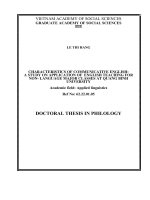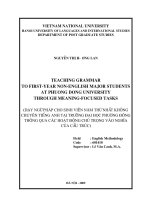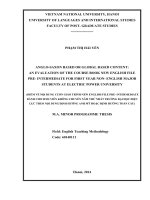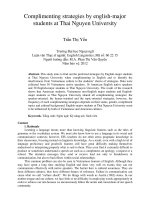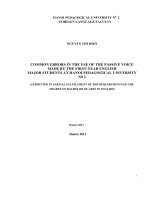Vocabulary extension through English – American literature course for English major students at Quang Binh University
Bạn đang xem bản rút gọn của tài liệu. Xem và tải ngay bản đầy đủ của tài liệu tại đây (283.06 KB, 10 trang )
Hue University Journal of Social Science and Humanities
ISSN 2588–1213
Vol. 127, No. 6B, 2018, Tr. 67–76; DOI: 10.26459/hueuni-jssh.v127i6B.4958
VOCABULARY EXTENSION THROUGH ENGLISH –
AMERICAN LITERATURE COURSE FOR ENGLISH MAJOR
STUDENTS AT QUANG BINH UNIVERSITY
Vo Thi Dung*
Quang Binh University
312 Ly Thuong Kiet St., Dong Hoi, Quang Binh, Vietnam
Abstract. Vocabulary is one of the most important elements in learning foreign languages, which is the
foundation for developing language competence. The main premise of the paper focuses on the background of vocabulary knowledge and then analyses the hurdles that English major students may encounter when engaging in learning languages and the factors that provoke communicative misunderstanding.
This paper suggests certain effective strategies to better help the English major students through an English – American literature course at Quang Binh University.
Keywords. vocabulary, English – American literature course
1.
Introduction
Developing vocabulary plays a very important role in the process of learning foreign lan-
guages. Vocabulary is specifically predictive and reflective of high levels of language achievement. Having a wide range of vocabulary means that students can operate more efficiently in
writing and speaking. Consequently, students need to improve vocabulary as it will enable
them to understand more of what is written or spoken in many cases. According to Wilkins
(1985), a person with a limited vocabulary will never be able to speak, write, read, or understand English effectively. Wilkins (1985, pp. 111–112) wrote that “. . . while without grammar
very little can be conveyed, without vocabulary, nothing can be conveyed”. Lewis (1993, p. 89)
went further to argue, “Lexis is the core or heart of language”.
There have recently been several studies by researchers into vocabulary such as Aronoff
(1994), Ehri (1994), Anderson (1996), Corson (1997) Bear, Ivernizzi, Templeton and Johnston
(2004). However, relatively little research has thoroughly and systematically studied how to
improve a wide range of vocabularies through an English – American literature course for English major students, especially at Quang Binh University.
Given the focus of this paper, we will not attempt to review the rather complex topic of
developing fluency. However, we do feel it is important to briefly address one aspect of decod* Corresponding:
Submitted: 18–12–2015; Revised: 04–01–2016; Accepted: 28–03–2017.
Vo Thi Dung
Vol. 127, No. 6B, 2018
ing that is crucial for English major students: the wide range of vocabulary frequency through
English – American literature.
2.
The important role of vocabulary for English major students
Vocabulary is central to English language teaching because, without sufficient vocabu-
lary, students cannot understand others or express their own ideas. Harmon (2005) as well as
Wood & Keser (2009) state that learners’ vocabulary development is an important aspect of
their language development. Schmitt (2000, p. 55) went further to argue, “lexical knowledge is
central to communicative competence and to the acquisition of a second language”. Different
researchers, such as Laufer and Maximo (2000), Read (2000), Pikulski and Templeton (2004),
Marion (2008), Nation (2011), Alali & Schmitt (2012) and others, have realised that the acquisition of vocabulary is essential for successful second language use and plays an important role in
the formation of complete spoken and written texts. As Schmitt (2010, p. 4) noted, “learners
carry around dictionaries and not grammar books”. Researchers such as Wilkins (1985), Huckin
(1995), Krashen (1993) have shown that second language learners rely heavily on vocabulary
knowledge and the lack of that knowledge is the largest obstacle for students to overcome. Additionally, by observing new words from other languages, students can discover the beauty and
novelty of the language through new words. They are able to consider the differences between
their mother tongue and voluminous foreign languages. This helps them to master the language
system of two languages, which is one of the important factors that people learn to communicate effectively.
Consequently, these students are likely to establish a better understanding of vocabulary
in language systems. Therefore, it is obvious that a lack of vocabulary in the learning process
will result in devastating consequences to their ability to learn other languages. Undoubtedly,
students who lack a great deal of academic vocabulary will be prone to failure in stimulating
their language deficiencies and making use of vocabulary learning strategies. Accordingly, due
to the essential impact of learning vocabulary, lecturers should significantly exert more effort on
enhancing their students’ capability to use a wide range of academic vocabulary.
For devoting attention to vocabulary, the research was carried out some interview questions which are open-ended questions such as most important, considerably important, marginally important, and do not know. The data was analysed according to statistical frequency and
converted into percentages.
68
Jos.hueuni.edu.vn
Vol. 127, No. 6B, 2018
Figure 1. Students’ opinions about learning vocabulary
From the statistic number (Figure 1), we can easily see that 58% (76) admitted that vocabulary is the most important while 25% (33) explained that vocabulary was as considerably important as grammar, pronunciation. Whereas, 13% (17) felt that vocabulary was marginally important. Only 4% (5) of the students did not know whether vocabulary was important. In general, more than half of the students realised the importance of vocabulary, which influences their
positive attitude towards learning it in class.
3.
Suggested strategies to extend English major students’ vocabulary
In conventional teaching approach, English vocabulary is taught in combination with
practical skills, such as listening, speaking, and writing. Therefore, many students acquire new
vocabularies by learning a large number of new words by heart, without taking into consideration their pragmatic uses in real communication. Without doubt, not only does this studying
method require a great deal of time and effort, but it is also of little help in supplying them with
adequate knowledge of language use. Generally, it is easier to remember words when they are
associated with other words in groups with real contexts.
Consequently, various researchers, such as Doff (1988) and Van Steensell (2012), do not
lend their support to this traditional learning method. Studying new words in this way, they
argue, heavily damages students’ creativity to use English vocabulary in a flexible way. In other
words, these students are only exposed to the words’ figurative meanings, thus, they are not
capable of taking advantage of these words in communications. As a result, an array of approaches has been successfully applied to advance English students’ vocabulary sources. One
possible measurement, which can be taken, is to randomly present students with new words
69
Vo Thi Dung
Vol. 127, No. 6B, 2018
during active language activities. Another plausible teaching approach is to supply English
words in real curriculums so that students can easily gain a deepening acquisition of vocabulary. Furthermore, studying with dictionaries or with various games is proven to be useful in
generating a new way for students to learn English words. Several leading experts in education,
such as Wright, Betteright and Bucky (1989), and Graves (2006), along with Niaidroose (2010),
expressed considerable support for using novels or biographies of well-known authors to enhance students’ academic words uses.
Because it is a changing, growing reality, English vocabulary is challenging. As Ur (2012,
p. 3) stated, unlike grammar, “lexical items . . . are an open set, constantly being added to (and
lost, as archaic words gradually go out of use)”. It means that students alike need to be in the
habit of learning vocabulary. Therefore, students can develop a growing love for English vocabulary learning and naturally share a passion for words and phrases in any language.
4.
The importance of English – American literature course in improving a
wide range of vocabularies
Irrefutably, reading a wide range of advanced references has a positive impact on devel-
oping English major students’ vocabulary sources. Indeed, several researchers, such as McKay
& Tom (1999), Carter and Mcrae (2001), Parrot (2001), Gurley (2006), Pieper (2006), Pathan & AlDersi (2013), have claimed that teaching English – American literature has countless benefits for
both students and lecturers, especially in presenting new knowledge in a vivid and novel way.
According to Hill (1986), the reading of literature provides an opportunity for the language to
be internalised whereby vocabulary already learnt can be reinforced. Ur (2011) states that literature provides examples of different styles of writing while also being a basic for vocabulary
expansion.
Literature, especially in the form of a masterpiece or added biographies, is a golden
source of vocabulary and a blend of various invaluable English structures. In addition, typical
works being used in learning provide lecturers with priceless advantages to get their students
to cross the most complex ideas of English words, which obviously helps the students to establish a firm foundation of language competence. Likewise, bringing literature novels into use in
higher education offers English students significantly more vocabularies than simply studying
endless papers of new words by heart. Additionally, popular novels and well-known works
consist of substantially many priceless cultural features. As a consequence, using these special
works undoubtedly broadens students’ knowledge about foreign cultural identities as well as
their traditional styles.
70
Jos.hueuni.edu.vn
Vol. 127, No. 6B, 2018
To accomplish the course goal, we also analysed the students’ evaluation on improving
English vocabulary designed in the teaching of English – American literature. The majority of
investigated students (accounting for 74%) supposed that pictures, videos, and other illustrations were relatively good for their learning because they make the students more interested
and more motivated in the study process. Surprisingly, up to 80% of the students believed that
“Gap-filling”, “Matching”, “True/False”, “Complete sentences with prompts given”, “Multiple
choices”, etc. would make them get access to the content and help them avoid some unwanted
obstacles in learning.
In conclusion, students do not only need to know a single word of English, but it is also
necessary for them to accumulate basic cultural knowledge about different layers of English
words’ meanings to understand the overt meaning, along with the subtle meaning of what the
author has written.
5.
English – American literature teaching and curriculum design at
Quang Binh University
English – American literature is a mandatory curriculum of English language bachelor
programs in many Vietnamese universities, such as Hanoi University, Hanoi National University of Education, Diplomatic Academy of Vietnam, Foreign Trade University, Thai Nguyen University of Technology, University of Foreign Languages–Hue University, Danang University of
Language Study, Quang Nam University, Ha Tinh Unversity. As a result, designing the course
is awarded by educators and lecturers to align students' needs and foreign language curriculum
requirements in the shortened time in class. Moreover, students’ background knowledge of
English and American literature and their literary analysis skill is very limited. A recent survey
has shown that most English major students of Quang Binh University never read an authentic
literary work in English. Therefore, lecturers should think of supporting students in their selfstudy, especially in a variety of vocabulary.
At present, English – American literature is included in the curriculum Quang Binh University as a mandatory course for the English majors in different training modes: full-time, parttime, and in-service. The course introduces to the students a glimpse of English and American
literature and gives them a chance to further explore the typical authors and masterpieces in
Britain and the United States as well as their language competence and their self-study ability.
Our English – American literature program can be specified in themes as follows:
Part I. English Literature: Survey of English literature; The Old English literature; The
Middle English literature; The Modern English literature.
71
Vo Thi Dung
Vol. 127, No. 6B, 2018
Part II. Survey of American literature (Early American and colonial period to 1776); The
Middle American literature; The Modern American literature.
Both part I and part II include a brief social-historical background, characteristics, and
major authors.
Table 1. Students’ attitude towards learning literature
No.
1
2
3
Students’ opinion
Number of respondents
Percentage, %
53
40
53
40
26
20
I like learning literature and doing the
tasks in textbooks.
I am afraid of learning literature because
I do not know how and what to do with
the tasks.
I hate literature because it is difficult.
Table 1 shows that 40% of the student responded that they like learning literature and
doing the tasks in textbooks. Forty percent of the students found literature difficult because
they do not know how and what to do with the tasks. The proportion of the students who dislike literature estimates 20%. They explained that the vocabulary in literature is very difficult
and they spent a great deal of time memorising list of words or finding out the main ideas. Over
70% of the students agreed that they feel frustrated with the length of novels or plays. Many
students who joined in the English and American literature course showed that they had a limited knowledge of literary terms. Moreover, literature manipulates various rhetorical devices,
figurative language, symbolism, similes, metaphor that make students become confused and
cannot understand the hidden meaning, the themes of famous works. Another problem is that
many students have limited knowlegdge of the culture and social different in literature prevented them from understanding the novels, poems, prose, etc.
Based on the data survey, the redesigning English and American literature course at
Quang Binh University was carried out to have students done their learning objectives by building up a word field related to their own area. Three components of the English and American
literature module are briefly described as follows:
+ The course goal: Based on the free online resources, lecturers can assist students in understanding and analyzing literary works along with their principal skills. There are three main
factors determining the English and American literature course, namely, to provide students
with the main literary history and movements in the periods of American and British literature
from the ancient, middle, and modern events; to introduce a brief social-historical background,
characteristics, and typical authors; to equip students with literary devices and constituent elements of the short stories, poetry and non-fiction essays. These are guides for English major
students to do their literary plan on a favorite author and his/her works during the course; to
72
Jos.hueuni.edu.vn
Vol. 127, No. 6B, 2018
equip students with literary devices and constituent elements of the short stories, poetry, and
non-fiction essays to assist students in understanding and analysing literary works. Accordingly, students have realised that they have a greater chance of being able to widen their range of
vocabulary.
+ The textbook and references: In terms of literary work selection criteria, the lecturers
suggested students to read original texts in real-life contexts for a literature course. Simultaneously, the lecturers should consider choosing suitable materials according to the following
criteria: interesting topics, manageable length, and appropriate level of language difficulty.
+ The main material and references: For students to infiltrate foreign literature, lecturers
ask students to read the original texts. To avoid difficulties due to limited time or background,
lecturers should consider choosing suitable materials according to the following criteria: the
balance between literary history and literary theory; medium strength properties and typical
properties of the compositions. Besides, lecturers should encourage students to widen their
knowledge to meet learning needs. In addition to the lecture material provided in class, lecturers introduce additional references or web addresses on English and American literature. Within a limited timeframe and textbook printing, we integrate some free online Internet resources
in the course so that students can use them as their references for further reading or their assignments. This way would be a good motive for students to understand the work better.
+ Teaching methods: According to Carrell & Eisterhold (1983), Akyel, A. and E. Yalcin
(1990), Carrell et al. (1989), and Chamot et al. (1999), the ultimate aim of foreign language teaching is to shape students into competent language learners. They argued that reading comprehension in literary is neither simply a unidirectional information-receiving activity nor a comprehension of words, sentences, and texts. The readers construct a certain cerebral mode in the
reading process, a comprehension-aimed, multi-strigiform, and interactive process that requires
consistent inferring.
The English and American literature course provides students with an access to English
through a very interesting channel, which is literature. Students would benefit considerably in
expressing their own ideas and feeling by building up a variety of words. An interactive process
in the English and American literature course shows that a literary work affects students
through its words, content, and structure, whereas they apply their background knowledge to
act on the text, thus encouraging them to communicate fluently in class. Consequently, it is such
a way that students can engage in interactive activities in class with their classmates, such as
developing their literary critical skills, discussing and presenting their opinions/feelings and
perspectives during the seminar. On the basis of teaching experience of English and American
literature course, we realised that students are so eager and creative in making their presentations grip the class attention using multimedia support like films, songs, and dramas.
73
Vo Thi Dung
Vol. 127, No. 6B, 2018
+ Assessment: Assessment is regarded to be part of the students’ learning process and
takes place over the course time. Students at Quang Binh University are encouraged to support
their classroom learning in small groups. The group presentations in literary seminars account
for 30% of the total score, in which student's speaking skill, public speaking skill, teamwork
skill, attitude toward learning, and literary knowledge are assessed by the lecturers. It is done
with varied methods from the lecturers and students. Moreover, students can self-evaluate their
own progression or success in the learning acquisition. The final term test (forming 70% of the
total score) is in a form of a literary portfolio, for which students must prepare during the
course time. At the end of the course, students would be able to understand more details about
their favorite authors and typical works so that they can enhance their understanding of literary
theory, aesthetic values, and the English language, which are the objectives of the course.
6.
The benefits of teaching English – American literature course
As will become evident, the role of cultural learning in the foreign language classroom
has been the concern of many lecturers and scholars and has sparked considerable controversy.
As Lessard-Clouston (1997) and Dixon-Krauss, (2002) noted, in the past, people learned a foreign
language to study its literature, and this was the main medium of culture.
Teaching an English and American literature course creates an interesting and flexible
environment to help students study English vocabulary. English and American literature stimulates students’ desire to widen their own knowledge about the cultures of English speaking
countries; hence, students are capable of learning how to use words correctly and diversely.
Moreover, being knowledgeable about the giant cultures of the United States and the United
Kingdom, the students can open a new horizon as well as improve vital language skills. This
subject also offers young people different layers of meanings of words and their uses, thus, resolving students’ difficulties in choosing the right words to use. Through a new language, students may gain an insight into the way words express thoughts, and so achieve greater clarity
and precision in their own communications.
Furthermore, one of the most advantageous ways to be fluent in a particular language is
to read novels or short stories. They provide students with chances to come across different
words in different forms, which consequently alter the way these students communicate in foreign languages. Therefore, they help students to remember words in the long term. As well as
developing broad vocabularies, students also remain updated and backdated; their general
knowledge will increase, and they will become intelligent, well-rounded people.
As in the study of any subjects, the study of literature builds thinking skills that are native to the subject but applicable outside the subject as well. Literature offers a unique education
in itself, representing a wealth of ideas, perspectives, worldviews, emotional insights and more,
74
Jos.hueuni.edu.vn
Vol. 127, No. 6B, 2018
all of which enrich the reader's "ideational vocabulary", expanding the range of thoughts and
ideas available to the reader. Not only do they build their vocabulary and reading comprehension skills, but students can also build their cognitive skills while annotating literature, and then
use those annotations to assist them in comparing or evaluating and analyzing the text in terms
of theme, conflict, figurative language, tone, or mood.
Conveying a sense of confidence when reading and evaluating original works written by
native speakers in a post-survey after the course, more than 70% of students responded that
they would certainly continue to read English literature and use literature as a means to improve their English competence. Although more time and measures are needed to assess the
results of the course, the student feedback demonstrates that the course is on the right track at
Quang Binh University.
7.
Conclusion
Literature is an amazing tool that all the previous researches have alluded to and it gives
insight into other cultures and their norms. The study of literature is important because it, at its
most basic, improves reading skills, especially a wide range of vocabulary. Good stories,
whether novels, short stories, plays, or poems, help students experience, in their minds, new
vistas, customs, cultures, and ways of life. This helps English majors students at Quang Binh
University thoroughly comprehend the differences between Vietnamese and other foreign languages. As students reach the high language level, their vocabulary knowledge and specific
literary repertoire are important factors for doing well in foreign language acquisition. In terms
of English competence, the integration of free online resources into teaching the English and
American literature content magnifies the interactions between the lecturers and students to
facilitate students' self- study. As a result, the teachers initially had positive feedback from students in improving their wide range of vocabulary.
References
1.
Akyel, A. and E. Yalcin (1990). Literature in the EFL class: A study of goal-achievement incongruence. ELT Journal, 44(3), 174–180.
2.
Anderson, R. C. (1996). Research foundations to support wide reading. In Creany, V. (Ed.), Promoting reading in developing countries, 55–77. Newark, DE: International Reading Association.
3.
Bear, D. R., Ivernizzi, M., Templeton, S., and Johnston, F. (2004). Words their way: Word study for
phonics, vocabulary, and spelling instruction. Upper Saddle River, NJ: Merrill/Prentice Hall.
75
Vo Thi Dung
4.
Vol. 127, No. 6B, 2018
Carrel P. L. and Eisterhold J. C (1983). Schema theory and ESL reading pedagogy. TESOL Quarterly,
17/4, 553–573.
5.
Corson, D. (1997). The learning and use of academic English words. Language Learning, 47, 671–718.
6.
Dixon-Krauss, L. (2002). Using literature as a context for teaching vocabulary. Journal of Adolescent
and Adult Literacy, 45(4), 310–318.
7.
Ehri, L. C. (1994). Development of the ability to read words: Update. In Ruddell R., Ruddell M., and
Singer H. (Eds.), Theoretical models and processes of reading (4th ed.), 323–358. Hillsdale, NJ: Erlbaum.
8.
John J. Pikulski, Shame Templeton (2004). Teaching and Developing Vocabulary: Key to Long-Term Reading Success. Houghton Mifflin Company, U.S.A.
9.
Ur P. (1991). A Course in Language Teaching: Practice and theory. Cambridge: Cambridge University
Press.
10. Wilkins, D. A. (1985). Linguistics in Language Teaching. Edward Arnold, London, UK.
76
